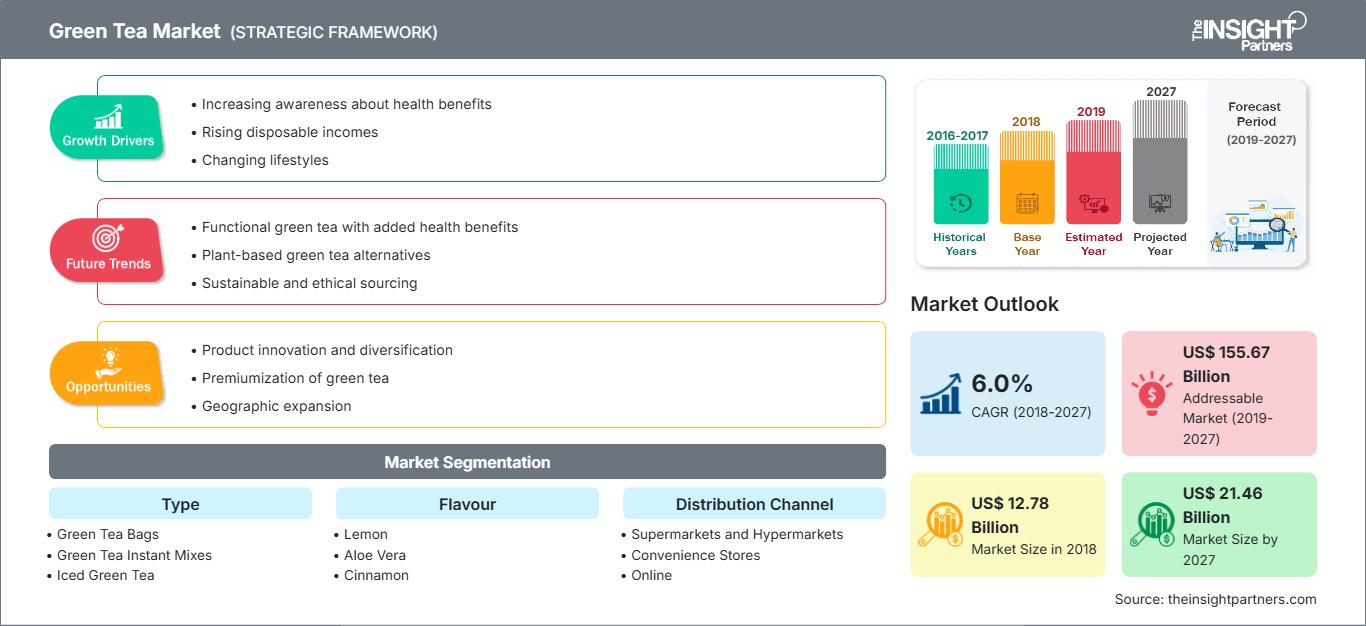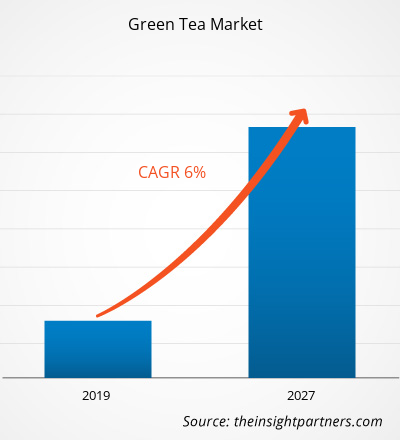Il mercato del tè verde è stato valutato a 12.777,6 milioni di dollari nel 2018 e si prevede che crescerà a un CAGR del 6,0% dal 2019 al 2027, raggiungendo i 21.456,2 milioni di dollari entro il 2027.
Il tè verde è preparato dalla pianta Camellia sinensis. Le gemme e le foglie essiccate della pianta Camellia sinensis vengono utilizzate per la preparazione del tè verde. La preparazione avviene friggendo in padella e cuocendo a vapore le foglie, seguite da un'essiccazione. Il tè verde è generalmente prodotto mediante la tecnica dell'idrolisi enzimatica. È noto che il tè verde è benefico contro vari problemi di salute, come la depressione, vari tipi di cancro, come il cancro ai polmoni, al fegato, al colon, allo stomaco e molti altri. Alcuni studi scientifici hanno anche dimostrato che il consumo di tè verde è benefico per migliorare le capacità di pensiero e aiuta anche ad abbassare il colesterolo e i trigliceridi nell'organismo. Nel 2018, la regione Asia-Pacifico detiene la quota maggiore del mercato globale del tè verde. La maggiore quota di mercato della regione Asia-Pacifico è attribuibile principalmente ai cambiamenti negli stili di vita dei consumatori e alla preferenza per prodotti alimentari sani e naturali. Si prevede che la domanda di tè verde aumenterà nella regione, con la crescente consapevolezza dei benefici per la salute attribuiti al consumo di tè verde. I produttori di tè verde stanno espandendo le loro attività produttive in paesi sviluppati come Cina, India, Giappone e Corea del Sud, per soddisfare la crescente domanda di tè verde nella regione, che dovrebbe ulteriormente espandere la crescita del mercato del tè verde nella regione.
Personalizza questo rapporto in base alle tue esigenze
Potrai personalizzare gratuitamente qualsiasi rapporto, comprese parti di questo rapporto, o analisi a livello di paese, pacchetto dati Excel, oltre a usufruire di grandi offerte e sconti per start-up e università
Mercato del tè verde: Approfondimenti strategici

- Ottieni le principali tendenze chiave del mercato di questo rapporto.Questo campione GRATUITO includerà l'analisi dei dati, che vanno dalle tendenze di mercato alle stime e alle previsioni.
Market Insights: i benefici per la salute del tè verde aromatizzato influenzano la crescita del mercato del tè verde
Potrai personalizzare gratuitamente qualsiasi rapporto, comprese parti di questo rapporto, o analisi a livello di paese, pacchetto dati Excel, oltre a usufruire di grandi offerte e sconti per start-up e università
Mercato del tè verde: Approfondimenti strategici

- Ottieni le principali tendenze chiave del mercato di questo rapporto.Questo campione GRATUITO includerà l'analisi dei dati, che vanno dalle tendenze di mercato alle stime e alle previsioni.
I consumatori delle regioni sviluppate e in via di sviluppo sono diventati più consapevoli della propria salute al giorno d'oggi. Il tè verde è prodotto da foglie e germogli di Camellia sinensis e non prevede il processo di appassimento e ossidazione. È noto che il consumo di tè verde previene il cancro, la cirrosi epatica, l'obesità, la pressione sanguigna e molte altre malattie croniche. Aiuta anche a perdere peso poiché è composto da sostanze bioattive, tra cui caffeina e polifenoli, che aiutano a scomporre le cellule adipose e a scaricarle nel tratto circolatorio, aumentandone così la domanda. Una bevanda preparata combinando tè verde e limone offre numerosi benefici per la salute, poiché possiede diverse proprietà antinfiammatorie e antimicrobiche. Si dice che il tè verde all'Aloe Vera contenga nutrienti come aminoacidi, vitamine, minerali, polisaccaridi ed enzimi. Il tè verde alla cannella aiuta a combattere i disturbi digestivi e di stomaco e migliora la digestione migliorando la capacità dell'organismo di scomporre correttamente il cibo e assorbire efficacemente i nutrienti. Il tè verde al basilico aiuta ad acuire la memoria e a ridurre l'ansia. Il tè verde Tulsi è ricco di fitonutrienti e antiossidanti che aiutano a proteggere l'organismo dai radicali liberi. Si prevede che l'ampia gamma di applicazioni del tè verde e la crescita costante della filiera avranno un impatto positivo sulle dimensioni del mercato.
Approfondimenti sulle tipologie
Il mercato del tè verde, in base alla tipologia, è suddiviso in bustine di tè verde, miscele di tè verde istantanee, tè verde freddo, tè sfuso e altri. Il segmento delle bustine di tè verde ha rappresentato la quota maggiore del mercato globale del tè verde. Inoltre, si prevede che il segmento delle foglie sfuse registrerà una crescita significativa nel periodo di previsione. Le bustine di tè verde sono generalmente realizzate in carta da filtro, plastica alimentare o cotone di seta. Le bustine di tè verde sono disponibili in diversi gusti come zenzero, menta e limone. Poiché le bustine di tè verde sono facili da trasportare e possono essere preparate all'istante, sono molto apprezzate nelle aree urbane. Inoltre, la crescente importanza di aromi innovativi, unici ed etnici nel tè verde sta aumentando la domanda di bustine di tè verde sul mercato. Il crescente utilizzo di bustine di tè verde ha un impatto positivo sulle dimensioni del mercato.
Approfondimenti sul gusto
Il mercato del tè verde è segmentato in base al gusto, come limone, aloe vera, cannella, vaniglia, basilico e altri. Il mercato globale del tè verde, in base alla forma, è stato guidato dal segmento al limone, che ha detenuto la quota di mercato maggiore. Il tè verde al limone è ricco di antiossidanti, flavonoidi e altri fitonutrienti che aiutano a combattere diverse malattie croniche e acute. È disponibile anche sotto forma di tè verde al limone freddo. L'aggiunta di succo di limone fresco al tè verde contribuisce anche ad aumentarne le proprietà medicinali, migliorandone il gusto. La combinazione di tè verde e succo di limone produce una bevanda ricca di vitamina C, dalle proprietà antinfiammatorie e antimicrobiche. Migliora anche la salute del cuore e la luminosità della pelle. L'aroma rilassante del tè verde al limone è apprezzato dai consumatori per i suoi molteplici benefici per la salute.
Approfondimenti sui canali di distribuzione
In base al canale di distribuzione, il mercato globale del tè verde è suddiviso in supermercati e ipermercati, minimarket, online e altri. Nel 2018, il segmento dei supermercati e degli ipermercati ha guidato il mercato globale del tè verde. Ipermercati e supermercati sono negozi self-service che offrono un'ampia varietà di prodotti a base di tè verde, come miscele di tè verde e tè verde freddo, diversi gusti di tè verde tra cui basilico, tulsi, miele, limone ecc. Questa vasta gamma di prodotti è esposta in modo molto organizzato in diverse sezioni e scaffali per attirare i clienti. Questi tipi di negozi offrono ai consumatori un'ampia scelta di prodotti di diverse marche in un unico posto e a prezzi accessibili rispetto ad altri canali di distribuzione. L'ampia disponibilità di prodotti a base di tè verde di diverse marche a prezzi più bassi ha incoraggiato i clienti ad acquistare tè verde da ipermercati e supermercati. Supermercati.
Diverse strategie sono comunemente adottate dalle aziende per espandere la propria presenza a livello mondiale, il che influisce ulteriormente sulle dimensioni del mercato. Gli operatori presenti nel mercato del tè verde adottano la strategia di espansione e investimento in ricerca e sviluppo per ampliare la base clienti e acquisire quote di mercato significative in tutto il mondo, il che consente loro anche di mantenere il proprio marchio a livello globale.
Mercato del tè verde
Le tendenze regionali e i fattori che influenzano il mercato del tè verde durante il periodo di previsione sono stati ampiamente spiegati dagli analisti di The Insight Partners. Questa sezione analizza anche i segmenti e la geografia del mercato del tè verde in Nord America, Europa, Asia-Pacifico, Medio Oriente e Africa, America Meridionale e Centrale.
Ambito del rapporto sul mercato del tè verde
| Attributo del rapporto | Dettagli |
|---|---|
| Dimensioni del mercato in 2018 | US$ 12.78 Billion |
| Dimensioni del mercato per 2027 | US$ 21.46 Billion |
| CAGR globale (2018 - 2027) | 6.0% |
| Dati storici | 2016-2017 |
| Periodo di previsione | 2019-2027 |
| Segmenti coperti |
By Tipo
|
| Regioni e paesi coperti | Nord America
|
| Leader di mercato e profili aziendali chiave |
|
Densità degli operatori del mercato del tè verde: comprendere il suo impatto sulle dinamiche aziendali
Il mercato del tè verde è in rapida crescita, trainato dalla crescente domanda da parte dei consumatori finali, dovuta a fattori quali l'evoluzione delle preferenze dei consumatori, i progressi tecnologici e una maggiore consapevolezza dei benefici del prodotto. Con l'aumento della domanda, le aziende stanno ampliando la propria offerta, innovando per soddisfare le esigenze dei consumatori e sfruttando le tendenze emergenti, alimentando ulteriormente la crescita del mercato.

- Ottieni il Mercato del tè verde Panoramica dei principali attori chiave
- Tè verde in bustine
- Miscele istantanee di tè verde
- Tè verde freddo
- Tè sfuso
- Altro
Mercato globale del tè verde - Per gusto
- Limone
- Aloe vera
- Cannella
- Vaniglia
- Basilico
- Altro
Mercato globale del tè verde - Per canale di distribuzione
- Supermercati e Ipermercati
- Minimarket
- Online
- Altro
Profili aziendali
- AriZona Beverage Co.
- Associated British Foods plc
- Dilmah Ceylon Tea Company PLC.
- Finlays
- Hankook Tea
- ITO IT
- Kirin Holdings Company Ltd
- Nestlé SA
- Tata Global Beverages
- Unilever
- Analisi storica (2 anni), anno base, previsione (7 anni) con CAGR
- Analisi PEST e SWOT
- Valore/volume delle dimensioni del mercato - Globale, Regionale, Nazionale
- Industria e panorama competitivo
- Set di dati Excel
Report recenti
Rapporti correlati
Testimonianze
Motivo dell'acquisto
- Processo decisionale informato
- Comprensione delle dinamiche di mercato
- Analisi competitiva
- Analisi dei clienti
- Previsioni di mercato
- Mitigazione del rischio
- Pianificazione strategica
- Giustificazione degli investimenti
- Identificazione dei mercati emergenti
- Miglioramento delle strategie di marketing
- Aumento dell'efficienza operativa
- Allineamento alle tendenze normative




















 Ottieni un campione gratuito per - Mercato del tè verde
Ottieni un campione gratuito per - Mercato del tè verde